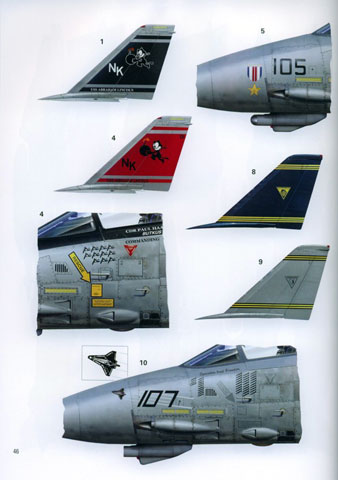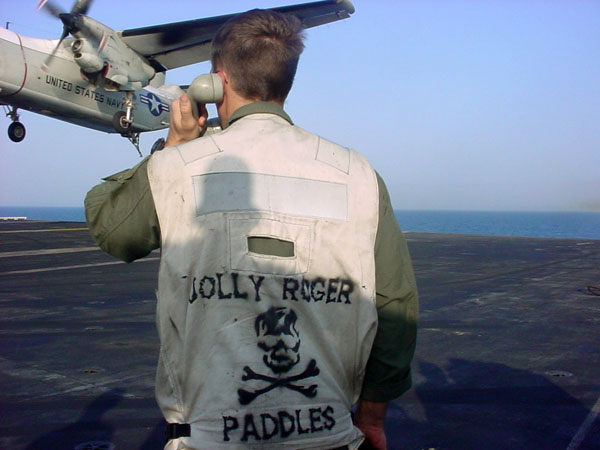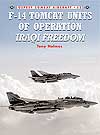S u m m a r y\
|
| Publisher and
Catalogue Details: |
Osprey Combat Aircraft No. 52 US Navy F-14 Tomcat Units of
Operation Iraqi Freedom by Tony Holmes |
| ISBN: |
1841768030 |
| Media and
Contents: |
Soft cover, 96 pages |
| Price: |
GB£12.99 online from Osprey Publishing
|
| Review Type: |
FirstRead |
| Advantages: |
A
comprehensive look at Tomcat Operations from Southern Watch
to major combat ops and into 2005. |
| Disadvantages: |
|
|
Recommendation: |
Highly Recommended
|
Reviewed by Ken Bowes

Osprey's
US Navy F-14 Tomcat Units of Operation Iraqi Freedom
will be available online from Squadron.com
I am of the view that no recent
air war has received so much detailed coverage so quickly as the ongoing
conflict in Iraq. In this regard one of the publishing houses at the
forefront has been Osprey Publishing. Their Osprey Combat Aircraft
series has to date covered F-15 Units, US Navy F/A-18 Units (part one of
a trilogy), US Army Apache Units and now in the latest volume (52) they
provide coverage of what is possibly the final fling of the F-14 Tomcat
as the last units rapidly stand down to reequip with the Super Hornet.
The author of this volume is aviation journalist and Osprey Combat
Aircraft Series Editor Tony Holmes. Tony, an Australian based in the UK,
has written extensively on the subject of US Naval Aviation in both
journals and books and is sufficiently well connected to make this
volume a worthwhile addition to the written history of the OIF air war.
 Not
taking any prior knowledge for granted, Holmes walks the reader through
some useful background, including the bitter experience of the 1991 war
and the subsequent development of the Bombcat in the 1990s. The result
is a good understanding of the dynamics of the US Naval Aviation that
resulted in the pre-eminent fleet defence fighter becoming the aircraft
of choice for precision strike and fast-FAC in 2003. The Tomcats role in
Southern Watch is then covered in detail, with first person accounts
dominating the narrative to illustrate the points made by the author. In
this volume the complex dynamics of Response Options and the mechanics
of strike and air defence ops in the box (as the area of the Southern No
Fly Zone was known) are explained in an accessible way, substituting
nicely for the lack of previous documentation of this highly structured
operation that kept Saddam Hussein in check for 12 years.
Not
taking any prior knowledge for granted, Holmes walks the reader through
some useful background, including the bitter experience of the 1991 war
and the subsequent development of the Bombcat in the 1990s. The result
is a good understanding of the dynamics of the US Naval Aviation that
resulted in the pre-eminent fleet defence fighter becoming the aircraft
of choice for precision strike and fast-FAC in 2003. The Tomcats role in
Southern Watch is then covered in detail, with first person accounts
dominating the narrative to illustrate the points made by the author. In
this volume the complex dynamics of Response Options and the mechanics
of strike and air defence ops in the box (as the area of the Southern No
Fly Zone was known) are explained in an accessible way, substituting
nicely for the lack of previous documentation of this highly structured
operation that kept Saddam Hussein in check for 12 years.
The real meat of the book though
is when Holmes turns to the phase of OIF now known broadly as major
combat ops. In “Shock and Awe”, “Shaping the Battlefield”, “Black
Knights” and “Northern War” the author covers in turn the strike and
close air support activities of the Tomcat squadrons as the war
progressed through March and April. The knowledge and skills of the
Tomcat FACs is particularly noted, as is the importance of the ability
of some models of the Tomcat to employ the JDAM, the weapon of choice in
this war for precision strike. The chapter “Black Knights” is worthy of
note as that squadron effectively split into two for the war, with one
half ashore teaching (and flying) FAC and SCAR (strike coordination and
reconnaissance) skills to the Strike Eagles of the 335th and
336th Expeditionary Fighter Squadrons of the USAF. It was
quite gratifying to note the praise heaped on the assistance provided by
75SQN RAAF in this chapter as they facilitated and supported the Tomcat
maintainers, allowing a much smaller shore detachment than would
otherwise have been required.
Holmes concludes this volume
with a look at ongoing operations over Iraq as the final few Tomcat
equipped carriers rotate through the Arabian Gulf as counter-insurgency
operations proceed in Iraq. As this chapter highlights, the flexibility
of a long endurance two seat FAC and SCAR aircraft operating in mixed
divisions with both Legacy and Super Hornets is something that will
likely be sorely missed by the USN. As with all other books covering the
recent conflict, this volume contains a lavish number of first person
accounts from the aviators that took the Tomcat into combat for the
final time. This is really the highlight of these books and brings a
wonderful personal perspective to an occupation that is both glamorous
and extremely dangerous. If for nothing else the words and pictures
supplied by many Naval Aviators from CAGs to lowly LT JGs make the
purchase price worthwhile.

Click the thumbnails below to view larger images:
As is usual for the Osprey
Combat Aircraft series included in this volume there is a useful
appendix covering all the units which have operated the Tomcat in
theatre up to the OIF III rotation of the JFK with VF 103 in late 2004.
18 colour profiles of Tomcats from all units fill the centre pages,
supported by 17 scrap views highlight tail art and mission log details
as applied to the aircraft. Modellers are well served with the
photographs and aircraft details which would support an accurate model
of an OIF Tomcat. The captions also contain a wealth of useful notes,
including discussion of various ordnance loadouts carried by different
squadrons, always useful to finish off an accurate replica. The majority
of included photographs are small, but in common with many of the
volumes on recent US subjects, includes a generous amount of colour.
The rarity of the photographs, many taken by serving members in theatre
is itself a reason to purchase this book. Yet again Osprey has published
an excellent volume on a topic of interest to many.
Highly Recommended.
Thanks to
Osprey Publishing for the review sample
US Navy F-14 Tomcat Units of Operation Iraqi
Freedom
(Combat
Aircraft No. 52) |

|
| |
 |
Author:
Tony Holmes
Illustrator: Jim Laurier
US Price: $19.95
UK Price: £12.99
Publisher:
Osprey Publishing
Publish Date: July 13, 2005
Details: 96 pages; ISBN:
1841768030 |
|
|
Review Copyright © 2005 by
Ken Bowes
Page Created 17 July, 2005
Last updated
17 July, 2005
Back to
HyperScale Main Page
Home | What's
New | Features
| Gallery |
Reviews | Reference
| Forum
| Search